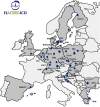Rationale and design of the EU-CERT-ICD prospective study: comparative effectiveness of prophylactic ICD implantation
- PMID: 30299600
- PMCID: PMC6351896
- DOI: 10.1002/ehf2.12367
Rationale and design of the EU-CERT-ICD prospective study: comparative effectiveness of prophylactic ICD implantation
Erratum in
-
Corrigendum.ESC Heart Fail. 2019 Aug;6(4):899. doi: 10.1002/ehf2.12444. Epub 2019 May 7. ESC Heart Fail. 2019. PMID: 31373446 Free PMC article. No abstract available.
Abstract
Aims: The clinical effectiveness of primary prevention implantable cardioverter defibrillator (ICD) therapy is under debate. The EUropean Comparative Effectiveness Research to Assess the Use of Primary ProphylacTic Implantable Cardioverter Defibrillators (EU-CERT-ICD) aims to assess its current clinical value.
Methods and results: The EU-CERT-ICD is a prospective investigator-initiated non-randomized, controlled, multicentre observational cohort study performed in 44 centres across 15 European Union countries. We will recruit 2250 patients with ischaemic or dilated cardiomyopathy and a guideline indication for primary prophylactic ICD implantation. This sample will include 1500 patients at their first ICD implantation and 750 patients who did not receive a primary prevention ICD despite having an indication for it (non-randomized control group). The primary endpoint is all-cause mortality; the co-primary endpoint in ICD patients is time to first appropriate shock. Secondary endpoints include sudden cardiac death, first inappropriate shock, any ICD shock, arrhythmogenic syncope, revision procedures, quality of life, and cost-effectiveness. At baseline (and prior to ICD implantation if applicable), all patients undergo 12-lead electrocardiogram (ECG) and Holter ECG analysis using multiple advanced methods for risk stratification as well as detailed documentation of clinical characteristics and laboratory values. Genetic biobanking is also organized. As of August 2018, baseline data of 2265 patients are complete. All subjects will be followed for up to 4.5 years.
Conclusions: The EU-CERT-ICD study will provide a necessary update about clinical effectiveness of primary prophylactic ICD implantation. This study also aims for improved risk stratification and patient selection using clinical and ECG risk markers.
Keywords: Implantable cardioverter defibrillator; Mortality; Risk factors; Sudden cardiac death.
© 2018 The Authors. ESC Heart Failure published by John Wiley & Sons Ltd on behalf of the European Society of Cardiology.
Figures
References
-
- Huikuri HV, Castellanos A, Myerburg RJ. Sudden death due to cardiac arrhythmias. N Engl J Med 2001; 345: 1473–1482. - PubMed
-
- Moss AJ, Zareba W, Hall WJ, Klein H, Wilber DJ, Cannom DS, Daubert JP, Higgins SL, Brown MW, Andrews ML. Prophylactic implantation of a defibrillator in patients with myocardial infarction and reduced ejection fraction. N Engl J Med 2002; 346: 877–883. - PubMed
-
- Bardy GH, Lee KL, Mark DB, Poole JE, Packer DL, Boineau R, Domanski M, Troutman C, Anderson J, Johnson G, McNulty SE, Clapp‐Channing N, Davidson‐Ray LD, Fraulo ES, Fishbein DP, Luceri RM, Ip JH. Amiodarone or an implantable cardioverter‐defibrillator for congestive heart failure. N Engl J Med 2005; 352: 225–237. - PubMed
-
- Priori SG, Blomstrom‐Lundqvist C, Mazzanti A, Blom N, Borggrefe M, Camm J, Elliott PM, Fitzsimons D, Hatala R, Hindricks G, Kirchhof P, Kjeldsen K, Kuck KH, Hernandez‐Madrid A, Nikolaou N, Norekval TM, Spaulding C, Van Veldhuisen DJ, Group ESCSD . 2015 ESC guidelines for the management of patients with ventricular arrhythmias and the prevention of sudden cardiac death: the Task Force for the management of patients with ventricular arrhythmias and the prevention of sudden cardiac death of the European Society of Cardiology (ESC). Endorsed by: Association for European Paediatric and Congenital Cardiology (AEPC). Eur Heart J 2015; 36: 2793–2867. - PubMed
-
- Al‐Khatib SM, Stevenson WG, Ackerman MJ, Bryant WJ, Callans DJ, Curtis AB, Deal BJ, Dickfeld T, Field ME, Fonarow GC, Gillis AM, Hlatky MA, Granger CB, Hammill SC, Joglar JA, Kay GN, Matlock DD, Myerburg RJ, Page RL. 2017 AHA/ACC/HRS guideline for management of patients with ventricular arrhythmias and the prevention of sudden cardiac death: executive summary: a report of the American College of Cardiology/American Heart Association Task Force on Clinical Practice Guidelines and the Heart Rhythm Society. Circulation 2018; 138: e210–e271. - PubMed
Publication types
MeSH terms
LinkOut - more resources
Full Text Sources
Medical
Research Materials




